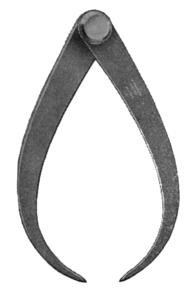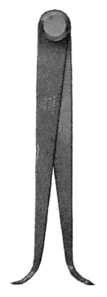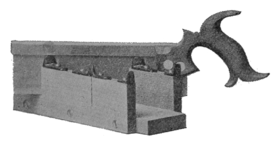generally used, but for particular work instruments with fine or sensitive adjustments are obtainable. Spring dividers (Fig. 13) are used for stepping off a number of equal distances, for transferring measurements and for scribing. Callipers (Figs. 14 and 15), obtainable in many styles, are used for measuring diameters of cylindrical solids and recesses.
Shooting Boards.—The shooting board (Fig. 16) is used for trueing up with a plane the edges of square stuff. That shown is the simplest possible, but other and improved shapes are obtainable.
Appliances for Mitreing.—The simplest appliance used in cutting mitres is the ordinary mitre block, the work being laid upon a rebate, and saw kerfs in the upper block serving as a guide for the tenon saw. Inclined and other varieties of mitre blocks are in use. The mitre box (Fig. 17) is generally used for broader mouldings. The mitre shooting block (Fig. 18) is used for shooting or planing the mitred ends of stuff previously sawn in the mitre block or box; in the illustration the rebate or bed for the work is cut out of the solid, but it is general to build up the block with three thicknesses of stuff, and so avoid cutting a rebate. The donkey's-ear shooting block (Fig. 19) is used for mitreing or bevelling the edges of wide but thin material with the cut at right angles to that adopted for stouter mouldings; another form of this block (Fig. 20) has a rest a for the material, A bed B for the shooting plane, a guide C for the plane, and a frame D which is fixed in the bench screw or to the tail of the bench. The mitre template (Fig. 21) is another aid to cutting mitres. Its use will be explained on a later page.
Spirit Levels.—The spirit level is used for determining the planes of the horizon—that is, the plane forming a right angle to the vertical plane. A frame firmly holds a closed glass tube nearly filled with anhydrous ether, or with a mixture of ether and alcohol (see Fig. 22). Good spirit levels have a graduated scale engraved on the glass tube or on a metal rule fastened to the frame beside it. There are many varieties of spirit levels, but all are made on the same principle.
Plumb Rule and Square.—The plumb rule (Fig. 23) is used by the carpenter and fixer for testing the vertical position of pieces of timber, framing, doorposts, sash frames, etc., which should be fixed upright. The plumb square (Fig. 24) is useful for testing






